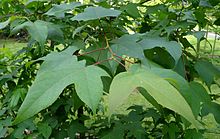Liquidambar acalycina
| Liquidambar acalycina | |
|---|---|

| |
| Scientific classification | |
| Kingdom: | Plantae |
| Clade: | Tracheophytes |
| Clade: | Angiosperms |
| Clade: | Eudicots |
| Order: | Saxifragales |
| Family: | Altingiaceae |
| Genus: | Liquidambar |
| Species: | L. acalycina
|
| Binomial name | |
| Liquidambar acalycina | |
Liquidambar acalycina, Chang’s sweet gum, is a species of flowering plant in the family Altingiaceae (formerly Hamameliaceae), native to southern China. Growing to 30–50 ft (9.1–15.2 m) tall by 20–30 ft (6.1–9.1 m) broad, It is a medium-sized deciduous tree with three-lobed maple-like leaves that turn red in autumn before dropping. It is monoecious, meaning that both male and female flowers appear on the same plant. The flowers are insignificant, yellow/green in colour, and are followed by small gum-balls that persist on the tree until winter. The wood exudes a sweet-smelling resin when pierced, giving the tree its common name.[3]
Liquidambar acalycina is cultivated as an attractive ornamental tree for parks and gardens, and is hardy down to −15 °C (5 °F) or less. It requires cultivation in reliably moist, acid to neutral soil in full sun or partial shade. The cultivar ‘Burgundy Flush’, with leaves opening purple, then green, then burgundy red in autumn, has gained the Royal Horticultural Society’s Award of Garden Merit.[4][5]
References
- ^ "Liquidambar acalycina". The Plant List. Retrieved 25 March 2018.
- ^ "Hamamelidaceae Liquidambar acalycina H.T. Chang". International Plant Names Index. Retrieved 25 March 2018.
- ^ "Liquidambar acalycina". Missouri Botanical Garden. Retrieved 25 March 2018.
- ^ "RHS Plantfinder - Liquidambar acalycina 'Burgundy Flush'". Retrieved 25 March 2018.
- ^ "AGM Plants - Ornamental" (PDF). Royal Horticultural Society. July 2017. p. 60. Retrieved 25 March 2018.
